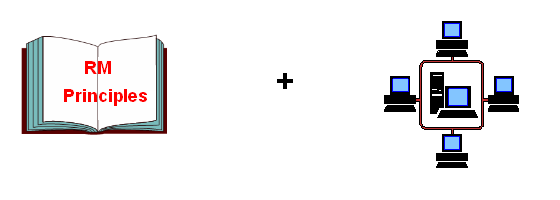
Electronic records management
What are electronic records?
Government bureaux and departments (B/Ds) create, receive and process tremendous amount of information during the day-to-day business operations and delivery of public services but not all of them are government records. A government record is any recorded information in any physical format or media created or received by a B/D during its course of official business and kept as evidence of policies, decisions, procedures, functions, activities and transactions. For example, a driving licence application will be kept as a record by the Transport Department as evidence of its business.
Development of information technology and the widespread use of networked computers to conduct government business have resulted in exponential growth of records being created digitally, e.g. e-mails, spreadsheets and electronic forms. These electronic records generated in digital form by an information system can be transmitted within the information system or from one information system to another; and stored in an information system or other medium.
Electronic records, like paper records that have been used in B/Ds for decades, are valuable assets to support effective decision-making, meet operational requirements and protect the legal, financial and other interests of the Government and the public. Therefore, electronic records should be properly managed and stored in a proper recordkeeping system, notably an electronic recordkeeping system.
What are the challenges for managing electronic records?
Electronic records have a vulnerable nature and present unique challenges for bureaux and departments (B/Ds) to manage them in view of :
| (a) | the fragility of the media (e.g. magnetic tapes, optical disc and USB drives) upon which they are recorded; |
| (b) | the dependency on technology to allow access and use of electronic records which cannot be read directly without the aid of computer software and hardware; |
| (c) | the ease of manipulation (i.e. updated, deleted, altered intentionally or inadvertently) without being discovered; and |
| (d) | the absence of self-evident and ready contextual information (e.g. who created it, when, to whom was it sent, why) to enable that electronic records are understandable and usable over time. |
Having regard to the above considerations and the need for proper control over electronic records, new records management policy, strategies, practices, procedures and tools benchmarked against international records management standards and best practices are required to support efficient and effective management of electronic records and non-electronic records under such an environment in B/Ds.
Electronic records management, which advocates the adoption of electronic means to manage electronic and non-electronic records in a consistent and integrated manner, has therefore evolved in recent years to provide the solution.
What is electronic records management?
Electronic records management (ERM) refers to the application of records management principles to manage records by using electronic systems, notably an electronic recordkeeping system (ERKS). ERM has been widely adopted and promoted in the public sectors of countries/union such as Australia, Canada, New Zealand, Singapore, the European Union, the United Kingdom and the United States of America. International professional bodies notably the International Council on Archives (ICA) have also devoted continuous efforts to develop standards, best practices and solutions for ERM.

With the growing need for proper management of electronic and non-electronic records in a consistent and integrated manner, it is the Government's records management policy to pursue ERM in government bureaux and departments (B/Ds).
As stipulated in the Government's Electronic Information Management (EIM) Strategy promulgated by the Office of the Government Chief Information Officer in May 2011, B/Ds should take forward ERM as an integral part of the EIM initiative and adopt an ERKS to drive ERM in the Government. It is a mandatory EIM requirement for B/Ds to develop their organisational EIM strategies encompassing an implementation plan to implement or adopt an ERKS before actual implementation of EIM projects.
What is an electronic recordkeeping system?
An electronic recordkeeping system (ERKS), also known as an electronic records management system in some jurisdictions, is an information/computer system with the necessary records management capabilities designed to electronically collect, organise, classify and control the creation, storage, retrieval, distribution, maintenance and use, disposal and preservation of records throughout the life cycle of records. It aims to manage records with the desired levels of confidence and integrity, by combining both advantages of electronic ways of working with well-established records management principles.
Based on the implementation experience of countries/union such as Australia, Canada, the European Union, New Zealand and the United States of America, an ERKS is commonly adopted as a solution to drive electronic records management in office setting.
An ERKS is particularly suitable for managing electronic records (such as e-mails, text documents and spreadsheets) created or received in the course of official business in a hybrid records management environment where both electronic and non-electronic records co-exist. It may take the form of a stand-alone system or as a part of a packaged solution of the departmental electronic information management (EIM) system of a bureau/department.